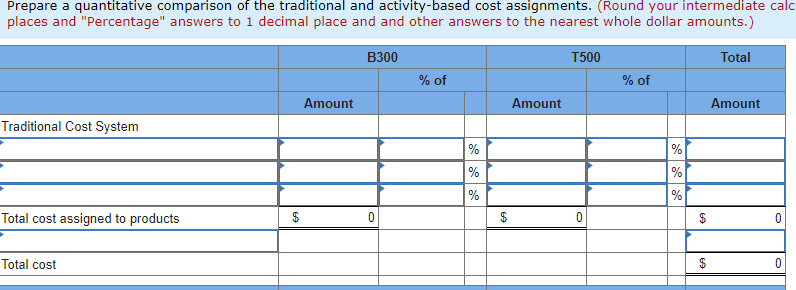Question
i-Tek Manufacturing, Inc., makes two types of industrial component partsthe B300 and the T500. An absorption costing income statement for the most recent period is
i-Tek Manufacturing, Inc., makes two types of industrial component partsthe B300 and the T500. An absorption costing income statement for the most recent period is shown:
| Hi-Tek Manufacturing Inc. Income Statement | |||
| Sales | $ | 1,641,900 | |
| Cost of goods sold | 1,223,526 | ||
| Gross margin | 418,374 | ||
| Selling and administrative expenses | 610,000 | ||
| Net operating loss | $ | (191,626 | ) |
Hi-Tek produced and sold 60,100 units of B300 at a price of $19 per unit and 12,500 units of T500 at a price of $40 per unit. The companys traditional cost system allocates manufacturing overhead to products using a plantwide overhead rate and direct labor dollars as the allocation base. Additional information relating to the companys two product lines is shown below:
| B300 | T500 | Total | ||||
| Direct materials | $ | 400,700 | $ | 162,600 | $ | 563,300 |
| Direct labor | $ | 120,600 | $ | 42,300 | 162,900 | |
| Manufacturing overhead | 497,326 | |||||
| Cost of goods sold | $ | 1,223,526 | ||||
The company has created an activity-based costing system to evaluate the profitability of its products. Hi-Teks ABC implementation team concluded that $56,000 and $102,000 of the companys advertising expenses could be directly traced to B300 and T500, respectively. The remainder of the selling and administrative expenses was organization-sustaining in nature. The ABC team also distributed the companys manufacturing overhead to four activities as shown below:
| Manufacturing Overhead | Activity | |||||
| Activity Cost Pool (and Activity Measure) | B300 | T500 | Total | |||
| Machining (machine-hours) | $ | 213,226 | 90,500 | 62,900 | 153,400 | |
| Setups (setup hours) | 123,000 | 80 | 220 | 300 | ||
| Product-sustaining (number of products) | 101,000 | 1 | 1 | 2 | ||
| Other (organization-sustaining costs) | 60,100 | NA | NA | NA | ||
| Total manufacturing overhead cost | $ | 497,326 | ||||
Required:
1. Compute the product margins for the B300 and T500 under the companys traditional costing system.
2. Compute the product margins for B300 and T500 under the activity-based costing system.
3. Prepare a quantitative comparison of the traditional and activity-based cost assignments.




Step by Step Solution
There are 3 Steps involved in it
Step: 1

Get Instant Access to Expert-Tailored Solutions
See step-by-step solutions with expert insights and AI powered tools for academic success
Step: 2

Step: 3

Ace Your Homework with AI
Get the answers you need in no time with our AI-driven, step-by-step assistance
Get Started


